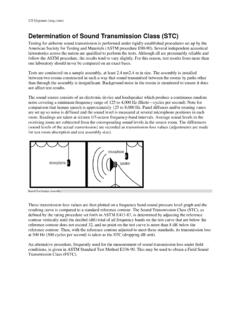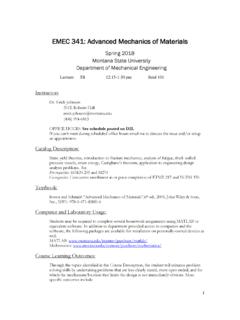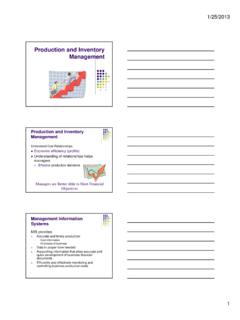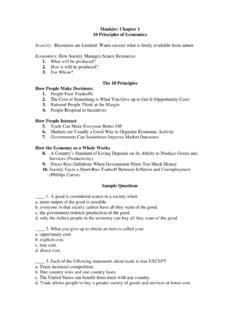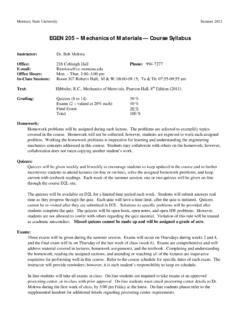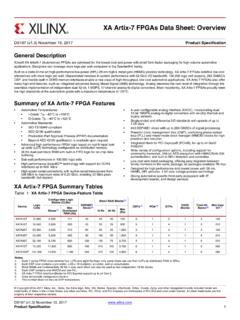Transcription of Chapter 10 Coherent Optical Communication Systems
1 Chapter 10 Coherent Optical CommunicationSystemsIoannis RoudasAbstractThe rapid evolution of long-haul Optical communications Systems ,witnessed in the last five years, is due to the gradual adoption of spectrally effi-cient, multilevel modulation formats, in conjunction with polarization divisionmultiplexing (PDM) and Coherent intradyne detection assisted by digital signalprocessing (DSP). The objective of this tutorial Chapter is to briefly review theoperating principles of state-of-the-art long-haul Coherent Optical communicationssystems. Due to limitations in space, it focuses mainly on Coherent Optical systemsusing quadrature phase-shift keying (QPSK) IntroductionThe commercialization in 2008 of the first 40 Gb/s Coherent Optical communica-tions Systems employing polarization division multiplexing (PDM) Quadraturephase-shift keying (QPSK) and intradyne detection assisted by digital signalprocessing (DSP) marked a major milestone in long-haul transmission [1,2].
2 Coherent receivers were intensively studied in the eighties [3 7] because oftheir superiority to their direct-detection counterparts, mainly in terms of sensi-tivity and frequency selectivity. However, they were considered impractical at thetime, due to their high cost and complexity, as well as their vulnerability to phase-noise and polarization rotations. The revived interest in Coherent detection islargely due to the substitution of previously proposed analog electronic andI. Roudas (&)Department of Electrical EngineeringUniversity of Patras26504 Rio, Greecee-mail: (Neo) Antoniades et al. (eds.),WDM Systems and Networks, Optical Networks,DOI: , Springer Science+Business Media, LLC 2012373optoelectronic modules (which were bulky, slow, expensive, and largely ineffi-cient) in Coherent Optical receivers with relatively inexpensive, high-speed,application-specific integrated circuits (ASICs) (see recent surveys [8 11,15] andthe references therein).
3 The latter enable adaptive electronic equalization of lineartransmission impairments, , chromatic dispersion, polarization mode dispersionand polarization-dependent loss, and to some extent, of fiber nonlinearities. Theyalso allow for adaptive electronic compensation of imperfections of the analogoptical transmitter and receiver front-ends, such as time skew of quadraturecomponents and polarization tributaries, quadrature and polarization imbalance,etc. Finally, they perform all standard digital receiver functionalities such asdigital clock recovery, intermediate frequency offset and phase-noise estimation,symbol decision, differential decoding, forward error correction, is an emerging consensus among major system vendors that coherentoptical PDM-QPSK communications Systems are the most attractive candidates for100 Gb/s Ethernet1transmission over existing terrestrial networks [2,12,16 19].
4 At the moment, several companies have announced the development ofapplication-specific integrated circuits (ASICs) for DSP in Coherent homodynesynchronous PDM-QPSK receivers operating at this symbol rate. Furthermore,recent field trials [21,22] have demonstrated the practicality of long-haul 28 GBdcoherent Optical PDM-QPSK M-ary Quadrature Amplitude Modulation (M-QAM) is actively investi-gated for use in next-generation long-haul terrestrial Optical communicationssystems [12]. This modulation format is intended for either single carrier or multi-carrier Systems using orthogonal frequency division multiplexing (OFDM), inorder to achieve equivalent bit rates of the order of 400 Gb/s or even 1 Tb/s perwavelength channel [12].
5 PDM M-QAM allows for a nominal spectral efficiencyof 2 M b/s/Hz. Recent hero experiments using Coherent Optical PDM M-QAMcommunication Systems achieved several world records, most notably unprece-dented aggregate WDM bit rates approaching 70 Tb/s [23,24] and a spectralefficiency close to 12 b/s/ Hz [25].Due to the proliferation of research studies on Coherent Optical PDM-QPSK andPDM M-QAM Communication Systems during the last five years, it is difficult toexhaustively cover all aspects of this topic here. The objective of this tutorialchapter is to briefly review the operating principles in long-haul PDM-QPSK Coherent Optical communications , it is necessary to use an effective bit rate of 112 Gb/s, which corresponds to a symbolrate of PDM-QPSK of 28 GBd, in order to achieve a net per channel 100 Gb/s data ratetransmission.
6 The reason is that one must take into account the overhead due to current forwarderror correction (FEC) (*7%) and the Ethernet packet header (*4%). We assume a WDMchannel spacing of 50 GHz, which is compatible with the current ITU grid specifications andprovides some margin for bandwidth narrowing due to the concatenation of several reconfig-urable Optical add-drop multiplexers (ROADMs). Then, the spectral efficiency of these Systems is2 b/s/Hz, , half of the nominal spectral efficiency of PDM-QPSK [12 14].374I. RoudasThe rest of the Chapter is organized as follows: InSect. , we initiallypresent the digital M-PSK transmitter and receiver optimal architectures in a blockdiagram form. Next, we review the operating principle of Coherent detection anddescribe different variants of Coherent receivers.
7 InSect. , we describe theimplementation of the functionalities of the optimal M-PSK transmitter andreceiver using various photonic devices, , a QM, a balanced receiver, a phase-diversity receiver with 90 hybrid, and a polarization-diversity receiver. , we review the most prominent DSP algorithms. Finally, inSect. ,wedevelop an abstract model for the performance evaluation of an Optical commu-nication system using M-PSK modulation and synchronous homodyne details of the calculations are given in the Multilevel Differential Phase-Shift KeyingMultilevel phase-shift keying (M-PSK) is a type of digital modulation formatwhereby information is encoded into discrete changesD/kof the phase of thecarrier at time instants equal to multiples of the symbol period [26,29].
8 Sincephase changes are less affected by additive white Gaussian noise compared toamplitude changes, this modulation format exhibits higher sensitivity thanamplitude shift keying (ASK). Signal RepresentationThe M-PSK signal can be written as [26]s t <~s t ejxst 10:1 where<:fgdenotes the real part and~s t is the complex envelope~s t AXN 1k 0ckg t kT 10:2 whereAis the carrier amplitude,Nis the number of transmission symbols,Tis thesymbol period,g t is the symbol shape, and we defined the complex symbolsck ejDuk 10:3 In , the discrete phase changesD/ktake values in the set2p i 1 =M UfgMi 1 10:4 whereUis an arbitrary initial Optical Communication Systems375 Substituting , using trigonometric identities, wecan express M-PSK modulation as the superposition of two carriers at the samefrequency but with 90 phase difference carrying M-ary amplitude modulations(calledin-phaseandquadrature components)s t I t cosxst|fflfflfflfflfflfflffl{zfflfflfflf flfflfflffl}in phasecomponent Q t sinxst|fflfflfflfflfflfflffl{zfflfflfflf flfflfflffl}quadraturecomponent 10:5 whereI t AXN 1k 0cosD/kg t kT Q t AXN 1k 0sinD/kg t kT 10:6 From , , we observe that symbolsckcan takeMdiscrete complexvalues.
9 A geometric representation of this set ofMcomplex values is shown The symbols are represented on the complex plane as a constellation ofequidistant points on a is worth noting that random bits at the entrance of the transmitter must bemapped into theMdiscrete complex values that symbolsckcan take prior totransmission. In , words ofm log2 Mbits are associated with differentconstellation points using Gray coding, , words corresponding to adjacentconstellation points differ by a single bit (see details below).Fig. representation of M-PSK signal sets on the complex planeaM 2;U 0;bM 4;U 0376I. Transmitter and Receiver ArchitecturesFrom , is straightforward to derive the block diagram of the QPSK transmitter.
10 An example of implementation of an ideal QPSK transmitter forU p=4:The transmitter does not segment the input PRBS intowords of two bits but instead, uses a serial-to-parallel converter to alternativelysend bits to two binary pattern generators. These produce two baseband antipodalbinary waveforms with instantaneous amplitude 1=ffiffiffi2pat symbol rateR 1=T;which modulate two CW carriersAcosxst; Asinxst:Therefore, a signaling ratereduction by one-half is achieved. The two quadrature components are added andtransmitted in the optimal synchronous QPSK receiver structure is shown in synchronous receiver is equipped with a carrier phase recovery circuit, whichcomputes the carrier phase changehacquired during propagation. The receivedwaveformisdividedintotwoparts,ea chmultipliedwithcosxst h ; sinxst h ;respectively, and filtered using two LPFs withimpulse responseg T t (matched filters).


